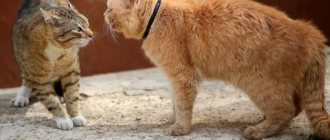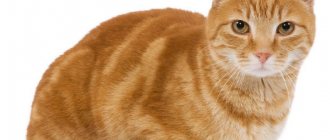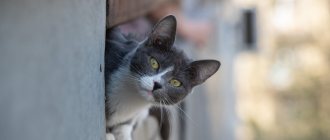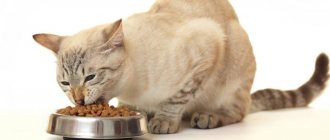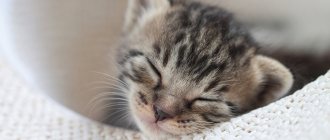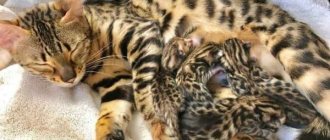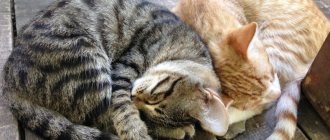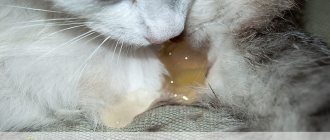Growing up in rural Idaho when spaying and neutering barn cats was unheard of, I received one of my most notable vocal lessons. My earliest feline sex education came from barn cats mating outside my bedroom window.
Duke was a large black long-haired cat who lived in the shade of our farm. His lover that evening was Punkin, an orange tabby cat.
Looking and sounding more like a fight than mating - with fur flowing, vocal cords taut like piano strings and teeth clenched - the actual copulation took only a few seconds. The courtship between Duke and Punkin was certainly more leisurely, taking place in a complex behavioral ballet that lasted several hours.
When to start?
A young cat matures by six months, and after two months it can even give birth. Unfortunately, before the age of one year, pregnancy is not always easy. Often the first litter consists of only one or two kittens with poor health, and sometimes the first kitten is stillborn. Therefore, you should not allow a cat to breed before she is one year old, but it is better to do this at the age of two years, so as not to risk the mother’s health.
Puberty in cats also occurs at the age of four to six months, after which the cat is constantly ready to reproduce. If you decide to castrate a cat, it is better to do it some time after puberty, but before one and a half years, otherwise the cat may retain the habit of marking its territory. For the full physical development of an animal, a healthy hormonal background is necessary, which is why it is worth waiting until the cat finally matures. In addition, the later you castrate a cat, the more masculine traits will remain in his character, and vice versa.
When sterilizing a cat, you should proceed from the same considerations, but age is less critical.
Estrus calendar for cats
The age of the first heat depends on the month the cat was born. Sexual hunting does not begin until six months, but usually does not occur in late autumn and winter.
| Month of birth | First heat | Age of the cat |
| January | February next year | 1 year |
| February | March next year | 1 year |
| March | September | 6 months |
| April | October | 6 months |
| May | February | 10 months |
| June | March | 10 months |
| July | February | 7 months |
| August | February | 6 months |
| September | March | 6 months |
| October | April | 6 months |
| November | May | 6 months |
| December | June | 6 months |
Is it worth it?
Unfortunately, our world is overflowing with unwanted cats and kittens who lead very unsweetened lives. Therefore, before you allow your cat to breed, think about whether you are ready to be responsible for her children. Even purebred animals with an excellent pedigree can give birth to sick or “rejected” kittens, let alone outbred cats. Maybe it’s better to give the foundlings from the orphanage a chance?
If you do decide to match your cat with a cat, be prepared for the fact that she may not let him near her simply because she does not consider him attractive enough. Mating occurs on the initiative of the cat, and therefore it is better to conduct dates on the cat’s territory so that the cat is not too aggressive and “intractable” towards him. Sometimes the animals immediately converge, sniff each other and begin the courtship ritual - the cat follows the cat, makes a voice, and the cat teases him, runs away and returns again. In some cases, you should leave them to their own devices for several hours so that the cat gets used to the room, and the cat gets used to the cat. It is better if the cat has a house in which she can hide from too intrusive courtship.
Preparation for mating
For cats
In order for the mating to take place and pregnancy to occur one hundred percent, it is necessary to monitor the frequency of the cat’s cycles in advance and be prepared - to find a suitable partner in advance, or better yet several, in case the only option turns out to be busy these days. The ideal time for mating is the third or fourth day from the start of estrus.
You can find a cat for mating by simply submitting an advertisement or contacting a club for breeding purebred cats. Then the animal owners sign an agreement in which they stipulate all the conditions, check the veterinary passport and health status of their partners, and, if necessary, look at the pedigree. Choose a cat with a suitable exterior, well-groomed and with the correct bite.
If this is the female’s first mating experience, then the male must be experienced, and vice versa. If both animals are virgins, it will be doubly difficult for them; conception will not take place, and an unsuccessful mating can lead to a categorical refusal of further attempts.
A few months before mating, all vaccinations are given, and a couple of weeks they are given anti-worm medication. It is forbidden to wash the cat for several weeks before mating - it will smell like chemicals, and not a secret that excites the cat; the cat can completely ignore her.
To prepare for bearing offspring, a cat requires enhanced nutrition, food rich in vitamins and minerals. Particular attention should be paid to the presence of calcium and folic acid in the diet, which are important for the formation of a healthy offspring.
Before sending your pet on a “date”, trim her claws - during courtship and mating, animals can seriously injure each other.
For the cat
In general, the rules are the same as for a cat - make sure your partner is healthy and has no genetic defects, evaluate her appearance and character.
About two weeks should pass from the moment of the previous mating, during which time the cat will rest, because each mating lasts from two to four days. If a cat has a busy mating schedule, he needs food rich in protein - it will help maintain strength and maintain high sperm quality.
It is better for a cat, just like a cat, to trim his claws and not expose his partner to the risk of being scratched.
Romantic meeting
The best time for mating is the second or third day after the cat starts estrus. Even with successful mating, ovulation and conception do not occur immediately, but after a day or two. Therefore, if during this time the cat had contact with several cats, any of them can become the father.
To increase the likelihood of conception, the cat and male cat should be allowed to be together for at least a day - during this time they will mate several times. At such moments, the cat screams loudly - this is in the order of things. At the same time, the cat behaves calmly but persistently, not paying attention to imaginary threats from the cat. If a cat shows aggression towards a cat, they may not be the best match and should be bred.
Animals are usually not interested in food at this time, but they must have clean water and access to a tray.
If conception has occurred, then the next day the cat calms down and becomes peaceful, which sharply contrasts with her behavior during estrus. Otherwise, estrus continues more or less vigorously for about another week. In unsterilized cats that do not have contact with males, echoes of estrus may appear for a long time until the next one begins. That is why it is better to sterilize cats prone to “nymphomania”.
Mating of purebred cats
Mating of purebred cats does not differ physiologically from outbred cats, but its goal is not just healthy offspring, but also maximum compliance with international breed standards. Here it is important to carefully select a stud cat, so this concern falls entirely on the shoulders of the cat’s owner.
The cat and the female cat must be of the same breed or similar breeds acceptable for crossing in the international system. For exhibitions, a good pedigree and the presence of champions and title holders are important. Inbreeding is not allowed, as this can lead to stillbirth, defects and mutations.
It is necessary to carefully consider the genetic characteristics of the manufacturer, evaluate the coat, tail length, eye color, and give preference to a cat with an exterior closest to the standard one. It is advisable to breed cats of a similar color in order to consolidate it in the kittens. The exception is white cats, since there is a high risk of manifestation of the hearing loss gene that accompanies the white coat gene.
If a cat has a deviation from the standard, then the cat should compensate for it, but not be the opposite. This means that if a cat has too small ears, this does not mean that you need to choose a cat with huge ears - this will not work. It is necessary to match the breed type.
Breeding British cats
British and Scottish cats are a bit similar. They are often confused by ordinary people, but breeders know all the differences inside out. However, Scottish Fold cats are descended from British cats as a result of a mutation in the ear cartilage, and the genotypes of the breeds are similar. Therefore, crossing them is prohibited - the risk of developing spinal pathologies is very high. British cats are bred only with cats of their own breed.
There are restrictions on mating according to color standards. There are two main groups of colors: black and red. Crossings are allowed only within the group, otherwise the kittens will be rejected. Golden Britons can only be bred with gold, sometimes with silver, and silver only with silver. The same goes for eye color: orange - with golden, copper, amber, green - only with green, the brighter the better. Blues are bred only with blues, but they carefully calculate the future color of the kittens' fur.
The round face of British cats leaves no one indifferent
Features of mating Scottish cats
The breed with folded ears is called the Scottish Fold. The main rule of mating Scots is that they are prohibited from breeding with the British and with their own breed.
Cute Scottish Fold ears
In the litter of a fold cat there are always two types of kittens: Scottish Fold and Scottish Straight. Straight are straight-eared kittens that do not participate in exhibitions and are used only for breeding - to obtain a healthy litter, you cannot breed two fold-eared animals. Otherwise, kittens are born with crooked legs, an abnormally thick tail, and death is possible.
Sphinx mating
Breeding sphinxes is a labor-intensive process. You need to have a good understanding of genetics in order to calculate the likelihood of dangerous mutations in future kittens based on the external data of the parents. The line between standard and deviation is extremely thin. Not all kittens in a litter will inherit the hairless gene; in some it will be hidden.
Since this breed appeared as a result of a mutation, there are frequent cases of the birth of unhealthy offspring. Therefore, hairless sphinxes are allowed to mate with velor or brush sphinxes with short hair, which have the remaining characteristics of the breed: thin long legs, slanted eyes, huge ears, high cheekbones, sharp muzzle with a weakly defined chin.
Graceful thin-legged sphinxes
Cat "in position"
Pregnancy in cats lasts from 58 to 78 days, depending on the size of the animal and breed, for example, Siamese cats bear kittens faster, large breeds longer. After about three weeks, the cat's nipples swell, and the fetus can be carefully felt in the enlarged tummy. At this time, the cat needs to be provided with plenty of nutritious food - it is better if it is special food for pregnant cats.
When there is one or two days left before giving birth, the cat becomes restless, looks for a secluded corner, clings to the owner and seems to be expecting something from him. Cats that are emotionally attached to their owner prefer to give birth next to him and can even do this in your bed, which you are unlikely to be happy about. Cats that tend to wander on their own may leave the house at this time in search of what they consider a safe place to give birth. It is better to prevent both of these extremes by providing the cat with a cozy house or box where she will make a “nest”.
Breeding cats outdoors
A barn cat, when she begins her period of heat and is ready to mate, secretes a special hormonal secretion, and it is its smell that attracts many males. They find the female, surround her and begin to fight for primacy, engaging in battle with each other. A barn cat has a large choice and chooses the male she likes the most. But, as a rule, the cat that won the fight with other male contenders will participate in mating.
The tactics of a cat are interesting, who at all costs wants to emerge victorious from the battle - by entering into skirmishes with other males, with each victory he becomes closer to his goal. But as soon as the cat glances at him, he feigns complete indifference. When a male conquers a female, he approaches her as close as possible and begins to scream heart-rendingly in her ear. If there was no negative reaction from the cat, she did not run away, but continued to lie in the appropriate position, sexual intercourse begins.
We deliver babies
- Urban dog breeds
- Origin of the cat
- Hypoallergenic dogs
- Fighting dog breeds
- The rarest cat breeds
- German Shepherd
There are three stages of childbirth. The developing fetuses, protected by the amniotic membrane, are attached to the wall of the uterus by the placenta, and are located in the horns of the uterus, which in a cat is bicornuate. The horns, at the point of their connection, pass into the uterine canal, which passes through the cervix into the vagina, and it, through the vestibule of the vagina, into the vulva. All these structures together are the cat’s birth canal. During the course of labor, three periods can be roughly distinguished. In the first period, the cervix dilates and the birth canal opens, in the second, kittens are born, and in the third, the placenta comes out.
The first stage of labor can last from 12 to 24 hours and in the initial stage it can be almost unnoticeable. And it all begins with chaotic, voluntary contractions of the uterus (pushing), during which the cat’s breathing quickens and she purrs to the beat. These contractions are at first rare and weak, looking like peristaltic waves from the top of the uterine horn to its body. The uterine horns contract alternately, gradually pushing the fetuses into the uterus.
The vagina swells a little a few hours before contractions, and a thick sticky discharge of a transparent, yellowish or bloody color appears from it. At this time, the cat becomes restless, licks the vulva (loop), strains as if during defecation, meows pitifully, and rakes up the bedding.
As the labor process progresses, contractions become more frequent and their duration increases, while the pain intensifies. During contractions (i.e. contractions of the uterus), the fetus is pushed further towards the cervix, and it dilates. And when the abdominal muscles begin to contract and the fetus moves into the vagina, the birth process is in full swing. At this time, a cat giving birth for the first time can be extremely frightened, and then she screams pitifully and seeks help from the owner, who must constantly reassure her by talking to her and caressing her.
During contractions, intrauterine pressure increases and the vascular membrane (chorion) ruptures. The amnion (water membrane) and allantois (urinary membrane), filled with fluid, are introduced into the cervix, expanding its canal like a hydraulic wedge. From this moment on, the cervix, uterus and vagina form one wide birth canal. During the formation of the birth canal, the presentation and articulation of the fetus is established for its exit from the uterine horn.
Gradually, pushing joins the contractions. They are caused reflexively, as a result of irritation of the nervous elements in the tissues of the cervix and pelvic walls by the presenting parts of the fetus. If you put your hand on the female's belly while pushing, you can feel it hardening. The pain continues to intensify, causing the cat to meow more and more pitifully and breathe frequently (like dogs in the heat). In between attempts she relaxes. Under the influence of contractions, supported by pushing, the fetus passes deeper and deeper through the birth canal. Gradually moving forward, the kitten comes out into the pelvis, and then is forcefully pushed further towards the exit from the vagina, passing part of the way with a strong contraction.
Second stage of labor
Usually on this section of the path the strength of the contractions is greatest. The water sac (amnion) surrounding the fetus appears between the labia of the vulva, ruptures, and a straw-colored fluid flows out. This is the release of amniotic fluid. Amniotic fluid lubricates the passage, facilitating the advancement of the fetus. Finally, part of the kitten (paw, head, tail) appears from the loop, appearing and then disappearing again.
As a rule, at this moment the cat relaxes and rests to gather strength. In classic cases, the cat makes two strong attempts at once and expels the kitten, connected by the umbilical cord to the afterbirth. The kitten is born with or without the membrane. About 70% of kittens are born in the "diver" position - with their forelimbs and nose first. The cat independently processes the baby, gnawing the membranes (if any), intensively licking the kitten's face, cleaning its nose, mouth and body, thereby stimulating its breathing and blood circulation, causes the first separation of feces, after which it gnaws the umbilical cord. The kitten takes a sharp breath, its lungs expand, and it begins to breathe.
Maternal instinct is a very important connection. The cat understands that this is her “baby” and she is obliged to take care of him. Sometimes from the outside it seems that she does everything rudely, but in fact she stimulates the cub’s breathing and blood circulation. The cat rests for some time after the birth of a kitten, then contractions and pushing resume, and the next kittens are born. Most cats kitten at intervals of 15 minutes to an hour. Two or three kittens may be born one after the other, but the next ones can be expected within another 3-4 hours, and sometimes longer. If a cat who is handling another kitten forgets to remove the amniotic sac, you must do it for her very quickly, otherwise the kitten will suffocate.
Third stage of labor
The separation of the placenta (baby place) is noted, which comes out a few minutes after the birth of each kitten. The mother will try to eat some or all of the placentas. This is a purely instinctive reaction, which may have been preserved from those ancient times when the animal had to strengthen its strength and destroy all traces of childbirth in order to save its offspring. However, she may not do this. Eating afterbirth leads to a laxative effect, that is, diarrhea. You can limit the amount of afterbirth she eats or let her eat them all.
Cats chew the umbilical cord, grinding it (in this case, the blood vessels are twisted and overstretched, and bleeding does not occur). If it is crossed too smoothly or too close to the navel, bleeding occurs. The umbilical cord should be compressed, tied with thread and cauterized with iodine or some other suitable antiseptic. It is important not to tighten the umbilical cord too much, so as not to provoke a hernia. Once some or all of the kittens have been born, the cat lies on her side and pushes them towards her nipples. Sucking kittens stimulates uterine contractions and the secretion of colostrum (mother's first milk), which contains all the necessary maternal antibodies.
Sometimes childbirth seems to stop, the Cat calms down and takes care of the kittens. Then, after 12-24 hours, labor resumes and the cat gives birth to the rest of her kittens. This is absolutely normal and there is no need to worry unnecessarily. There are no identical births; all cases are individual. It is quite difficult for a breeder with no experience to determine the boundary between the norm and the anomaly. It happens that a cat that has given birth to 3-4 litters without any problems suddenly develops complications during subsequent births and has to undergo a caesarean section. And vice versa.
Cats become sexually mature at eight months of age. Uncastrated males during this period tend to leave the master’s house, emit heart-rending screams, urinate everywhere to leave a mark on themselves, often show carelessness, are ready to fight every minute, attack various objects with sexual intentions, for example, soft toys, clothes made of wool, etc. P. If a cat in heat appears in a zone accessible to his sense of smell, the cat becomes so excited that it is sometimes very difficult to keep him at home. A cat's first mating experience is better with a cat that has already given birth. Breeding males are allowed to mate at first no more than once or twice a month, and then twice a week.Cats reach sexual maturity at five to nine months. They begin to demand attention, rub against various objects and people, and roll over onto their backs. The cat begins to tremble with excitement, loses appetite, and marks its territory with urine everywhere. Different cat breeds have different rates of estrus. It also depends on the conditions in which the animal is kept and what time of year it is. According to felinologists, in January and February cats come into heat for a few days, and in June and July it lasts longer. But for cat owners, this statement seems controversial. A cat's heat can last from three days when the cat is nearby and up to two weeks. During her first heat, a cat is quite reluctant to have sexual contact with a male cat. The reproductive period in cats is long. It happens that even twenty-year-old cats give birth.
The sexual behavior of cats, regulated by hormonal status, is characterized by cyclicity. Anaestrus - a period of sexual inactivity - lasts approximately four months and depends on the length of daylight hours. As a rule, it occurs when daylight hours are no more than twelve to fourteen hours. If there are artificial light sources in the cat’s place of residence, the period of passivity becomes shorter. As a rule, a cat has two or three periods during the year when she is sexually active. At the preparatory stage preceding mating - proestrus, the cat begins to caress, but at the same time shows anxiety. The cat's vulva is swollen, but there is no discharge yet. After one to three days, estrus begins - the phase of preparing the cat’s body for mating. The cat begins to meow, purr, sometimes makes heart-rending screams, and rolls from side to side on the floor. If you stroke the cat at this moment, she will take a certain pose, demonstrating her readiness to mate. The cat presses its belly to the surface of the floor, moves its tail to the side, and steps with its hind paws. During this period, the cat experiences a loss of appetite, rushes out of the house, and leaves marks everywhere.
Estrus can be very long, and in cats suffering from “nymphomania” it can last continuously. The smell of heat spreads throughout the neighborhood and all the cats from the area gather around the cat in heat, starting fights and “cat concerts.” When a cat mates freely, she can choose her partner. If breeding is carried out purposefully, a partner can be found through a cat lovers club. The main thing here is to prevent inbreeding - mating of close relatives.
With linear breeding of cats, it becomes possible to consolidate certain qualities in the offspring. When unrelated individuals mate, new properties and characteristics appear in the breed. According to breeders, it is better when the female is brought into the house where the male lives. It is not advisable to mate them on the first day. The best day for conception is considered to be the third day of estrus. As a rule, two matings (matings) are used. When mating, the cat crouches, lowers its head down, raises its pelvis and moves its tail to the side. The cat bites the cat's scruff, climbs onto the cat from behind, first with its front paws, then with its hind paws. Sitting on its hind legs, the cat commits coitus. The cat's hind legs are resting on the floor, and the cat moves closer to it so that the contact is closer. Cats sometimes become irritated, feel tired and often try to get rid of the cat. The copulation process lasts several seconds. On the male's penis, and this distinguishes him from other animals, there are pointed bristles that appear in 3.5-month-old kittens. When the cat removes the penis after coitus is completed, the cat most likely experiences pain, which is why it screams loudly and often rushes at the cat. Then the cat lies down on its back, apparently for better fertilization. It is better to immediately isolate the cat from the encroachments of other males, who may produce out-of-breed kittens.
If mating is successful, ovulation occurs after one to one and a half days. After another day or two, the signs of estrus disappear. If mating does not occur, estrus can last ten to twelve days. After the estrus phase comes di-estrus - a time of calm. Then, after seven to twelve days, signs of the beginning of the next cycle - proestrus - appear again. Repetition of sexual cycles in cats occurs after twenty-one days. In older cats, these cycles become shorter. From 10 to 12 percent of cats, which primarily include Siamese, do not have a period of di-estrus at all. These cats remain passionate for six to ten weeks, they emit inviting cries, and demonstrate in every possible way their readiness for mating, exhibiting “nymphomania.” The owners of such cats have a hard time. Cats do not have pronounced cycles of sexual activity. Their mating season lasts all year round, although in the spring their activity increases.
The optimal age for breeding is considered to be a female up to eight years old. At an older age, the gestation period becomes shorter and the risk of death of the offspring in the embryo increases. White cats with blue eyes are usually deaf, and for this reason they are bad mothers, because... They just don’t hear their pets scream. It is very difficult to call cats good dads. They extremely rarely take care of their offspring, and more often they simply do not pay attention to them. Cats try to keep their babies away from their dads, because... they can simply kill them. Often parents, showing cannibalism, eat their dead cubs themselves. When the kittens reach one month of age, the cat stops letting them suckle, pressing her belly to the floor and turning away from the cubs. Three-week-old kittens are already trying to lap from a bowl. Gradually they learn to eat food other than milk, incl. and hard.
If a cat gives birth no more than twice a year, this does not affect its health. Pregnancy in a cat can be determined by the first signs. Three weeks after ovulation, the nipples turn pink, and after another week they become swollen. On average, a cat's pregnancy lasts approximately nine weeks plus four days. The normal duration of pregnancy is considered to be from 58 to 72 days. But when birth occurs a week early, kittens rarely survive. After conception, in the first three weeks, the cat loses its activity, eats little, and sometimes begins to vomit. At four to six weeks, the embryos can already be felt through the abdomen. At six weeks, the belly grows greatly and becomes rounded. At seven weeks, fetal movements can be detected. The cat begins to worry and look for a place to make a nest.
In the last week before childbirth, the mammary glands swell, the nipples become enlarged, and white discharge appears from the vulva. The cat loses its appetite, it caresses its owner, licks its abdomen and vulva. Often during this period the cat vomits. When labor pains begin, the cat settles into the nest and fusses around in it. Liquid begins to leak from the nipples. This phase lasts from twelve hours to a day. The cat takes a lying position on its stomach. When the membrane of the fetus ruptures, the release of amniotic fluid begins, the kitten's head appears, and within fifteen minutes the cub completely leaves the mother's birth canal. If the head is delayed, the cat may require delivery. As the contractions progress, the kitten's muzzle and its front legs move outward. When the kitten is fully born, the cat tears the unruptured amniotic sac with its teeth. When a cat for some reason does not perform such actions, you need to urgently provide her with help before the cub suffocates. The umbilical cord does not rupture during childbirth, so within a fifteen-minute period after the birth of a kitten, the cat licks the cub and bites the umbilical cord. If the cat has difficulty with this, the umbilical cord is pulled from the kitten and cut at a distance of 20-40 mm from the cat’s belly. The placenta comes out with or after the baby. The number of placenta should be equal to the number of kittens born. A retained placenta can cause complications. As a rule, cats eat the afterbirth. It is best not to let your cat eat more than one or two placentas, otherwise she may experience vomiting and diarrhea. The next cub is born in ten fifteen minutes, maximum – in two hours. Labor lasts on average from two to six hours. It’s rare, but it happens when labor lasts a whole day or even a day and a half.
A cat that has just given birth needs rest. She should have food and drink nearby so that the mother does not have to leave her newborn kittens for a long time. As a rule, cats give birth to four to ten kittens, and even more. A cat cannot always feed all her cubs, so you need to leave her as many kittens as she can raise without compromising her and their health.
Newborn cat babies remain blind and deaf for about ten days, but have a good sense of touch and smell, which they need to find their mother's nipple. Kittens are born weighing from 57 to 115 grams. On average, a kitten's weight reaches 85 grams, and its length is from 10 to 12 centimeters. Four-day-old kittens can already use their paws to massage their mother’s abdomen to stimulate milk production. By the end of the first week of life, the kittens' eyes open and the baby's weight doubles. Month-old kittens are already playing, can sit and move around quite confidently. A kitten's eyes remain blue until they are three months old. Babies begin to cut their teeth at the age of one month. Until the age of one and a half months, the kittens do not leave the nest, constantly playing and fighting with each other. If the cat considers it necessary, she can move the kitten to another place by taking it by the scruff of the neck with her teeth. If the kitten has left the nest, but does not meow pitifully, the cat is unlikely to look for it. It is common for wild cats to change their nests frequently for safety. The cat takes the grown kittens out of the nest to teach them behavior and hygiene rules. Once they reach the age of six to eight weeks, kittens quickly get used to interacting and playing with people. At this age, you can grab a kitten by the scruff of the neck with one hand, holding it by the tummy with the other so that it does not resist such handling.
In the first weeks of life, kittens' weight increases rapidly. At the age of three weeks, kittens acquire the ability to see. At the age of one month, their milk teeth begin to grow, and now they can be fed with minced meat, accustoming them to a meat diet. Kittens do not need to be overfed. Food should always be fresh. You need to make sure that your kitten always has water available to drink. Within two months, babies' vision is completely stabilized.
White cats are very often naturally deaf. This defect is genetically inherited by them, except for cats that are related to representatives of the Burmese and Siamese breeds. Cats with blue eyes are also usually deaf. A white cat with one blue eye usually cannot hear in one ear. Completely deaf cats are incredibly cautious.
Kittens at the age of five months already know how to leave marks in their territory. Their milk teeth are replaced by permanent teeth. Six-month-old kittens are already completely independent from their mother. It is best to adopt an eight-week-old kitten. Kittens that are more than twelve weeks old and have not received enough attention have difficulty getting used to their new home and avoid humans. By the age of seven to eight weeks, kittens usually have baby teeth - fourteen on the upper jaw and twelve on the lower jaw. Kittens at this age weigh from 700 to 800 grams.
When a cat, having given birth to kittens, refuses to raise them or behaves aggressively towards them, the kittens are transplanted to another cat, also nursing. They are rubbed with the cat's urine or milk so that she considers them hers. If it is impossible to place them with another mother, the kittens are artificially fed and protected from the cold. On the first day of life, kittens need a temperature of 32 degrees C, then four to five days - 29 degrees. Kittens' resistance to temperature fluctuations increases with age. Kittens need to regularly change their bedding and monitor their weight. In the early postnatal period, kittens are fed using juice with a small hole, which allows the baby to swallow food normally and prevents food from entering the respiratory tract. As a temporary remedy, you can use a napkin soaked in milk, the tip of which the kitten can suck on, or you can give it food through a pipette. Infant formula and cow's milk are not very suitable food for babies, because... They don't have as much protein as cat's milk. Close in composition to cat milk, a mixture prepared from two tablespoons (tablespoons) of milk concentrate, two tablespoons of boiled water and a quarter teaspoon of glucose. The temperature of the mixture should be about 38 degrees C. If the kitten does not want to eat on its own, you need to carefully moisten the baby's face with the mixture. If your kitten's stool becomes looser, reduce your water intake. To prevent the kitten from developing conjunctivitis, its eyes should be washed with weakly brewed tea. Kittens need to be treated kindly - this helps to shape their character in the future.
At the age of eight to nine weeks, kittens become more independent and begin to bother the cat. It is better to remove kittens from their mother gradually, not all at once. Usually cats calmly tolerate parting with their children, but in some cases they show great excitement and search for their cubs until they realize that they are missing forever. The new owner of the kitten needs to be told about its infancy, the habits that were instilled by the mother, the vaccinations given and the treatments performed.
Assistance during childbirth
Of course, a doctor should help in difficult cases. But this does not mean that an experienced pet owner is not able to help, especially when delay is fraught with consequences. If contractions are insufficient, you can induce them by stroking your stomach and back with your hand. This measure is good when after the birth of several kittens the intensity of contractions weakens. You should not use medications that provoke contractions.
Help with stagnation of the baby in the birth canal
Depending on whether we are talking about the rear or front position of the kitten, the hind legs and parts of the pelvis or the head and front legs appear. In both cases, you can try to speed up labor by gently pulling. Especially with posterior presentation, there is a danger of compression of the umbilical cord and, as a consequence, the kitten inhaling amniotic fluid. With an anterior presentation, there is less danger of inhalation because the membranes are open and air can pass into the lungs during breathing movements. Under no circumstances should you pull on the head, as this will lead to the kitten’s death due to a fracture of the cervical vertebrae. They usually pull by the legs, a little to the left, a little to the right - alternately. It is best to pull the folds of skin on the animal’s neck or body, forming them with three fingers. If amniotic fluid has leaked and the birth canal is dry, your fingers should be soaked in Vaseline oil.
If the kitten is pulled out with force, this can lead to severe trauma and injury to the birth canal. You can’t drag it perpendicular to the cat’s body position! Only along the cat's body!
Postpartum period
For him, there is usually a slight increase in temperature. The general condition of the animal during this period does not show any significant deviations. Newborn kittens look for nipples when the mother is still giving birth to the rest, and begin to suck. At this time, they still cannot hear or see. The reason for this is that the eyelids are closed at birth, opening between 8 and 11 days (the ability to see appears in the next 5-10 days). The development of the outer ear is not complete at the time of birth, so the auditory opening is not distinguishable in kittens. It develops only between 9 and 11 days of age.
But at the same time, cats can pick up odors from the moment they are born. When breeding wild puppies and kittens in zoological gardens, it was found that after 48 hours they were able to recognize even different people by smell.
Additionally, they may exhibit temperature sensitivity and have tactile skills. Immediately after birth they are able to make sounds. All these manifestations serve for the joint life of mother and children at an early age.
Babies are only able to crawl on their stomachs and use their head movements to look for milk nipples. Temperature and contact perception are necessary so that the kitten does not lose communication with the mass of its peers and the mother cat herself. If this does happen, then the mother notifies about this in a complaining tone and places the fugitive in his place, in the “nest”. Because of these characteristics of newborn kittens, they are classified as nesting species of animals, because in the first moments of life they are not able to move independently. These species include dogs, rabbits, rats, mice, etc. The opposite is, for example, ungulates (horse, cattle, sheep and goat), which escape from the cradle. This also includes the brown hare and guinea pig and many other mammals.
Rules for choosing a partner and preparing animals
The choice of a female for a male must be approached with great responsibility, since the quality and quantity of kittens, genetic features, and the successful outcome of the mating itself will depend on the correct choice of partners. If the cat has already had sexual experience, it is worth looking at what the offspring from his previous matings were like.
The best choice would be a prepotent animal, since such a partner will be able to pass on the best genetic set to the kittens. To achieve the best litter from mating a cat with a cat, it is recommended to consult a specialist when choosing a partner.
Before mating, animals need to trim their claws so that they do not injure each other. It is not recommended to perform hygiene procedures on pets, much less bathe them using scented hygiene products. Individuals should exude a natural scent, this increases the likelihood that they will be able to make friends, and the mating will take place with the desired result.
It is recommended to carry out mating in the territory of the male.
In order for the female to feel comfortable in new conditions, you need to bring her litter tray, bowls for food and water, as well as food if it becomes known that the cat eats a different type of industrial diet.
The container with the cat is placed in the middle of the room and left with the door open. Forcibly pulling a cat out of such a shelter is strictly prohibited. The female must calm down on her own and begin exploring the territory. If you force a cat out, it may become very frightened and then refuse to leave the container at all.
When mating purebred cats, you need to take into account a number of nuances. So, for example, a fold-eared cat can only happen to a cat whose ears are straight, otherwise genetic abnormalities cannot be avoided in the resulting litter.
Popular questions
- How long does heat last? The duration of estrus (heat) is different for each cat. On average, estrus lasts seven days, but can sometimes reach 21 days. If the cat does not mate and does not become pregnant, the estrus may begin again, with two days between estruses.
- At what age can a cat become pregnant? A cat can become pregnant as soon as it reaches sexual maturity (about four months).
- At what times of the year can a cat become pregnant? Cats can become pregnant at any time of the year, especially in average climates, but mating and pregnancy occur most often in the spring.
- How long does pregnancy last in cats? 56 – 71 days. The average duration of pregnancy is 67 days.
- How many times a year can a cat kitten? Up to five times a year!
- On average, how many kittens can a cat give birth to at one time? On average, a stray cat gives birth to three kittens, but sometimes six kittens or more.
- Can a cat get pregnant while nursing kittens? Certainly! Typically, cats go into heat 1-2 months after giving birth, at which time they can become pregnant again. Some cats may go into heat a week after giving birth, which can lead to pregnancy.
- Is it possible to sterilize cats while they are nursing kittens? Yes. A cat that is spayed while nursing kittens will continue to produce enough milk for her kittens. Some veterinarians prefer to wait until the cat has stopped nursing her kittens before operating, because mammary gland development during nursing can make surgery difficult. If the cat can be kept indoors away from male cats, you can wait to have her spayed until she is no longer nursing kittens (then the entire family can be spayed or neutered). If the cat cannot stay away from cats while feeding, then she needs to be sterilized as soon as possible. Return your cat to kittens as soon as possible after surgery. If the lactating cat is feral and must be captured, it is advisable to capture the kittens as well (if possible), or wait until the kittens are at least six weeks old, so as not to leave the kittens without their mother for a long time.
- At what age do non-sterilized cats stop producing kittens? Unlike humans, cats do not go through menopause. Although fertility gradually declines over time, there is no specific age after which a cat can stop becoming pregnant.
- Can cats from the same litter mate and create kittens? Yes. It is for this reason that cats and female cats from the same litter living together must be spayed and sterilized before four months.
- Is it okay to let your cat give birth once before getting spayed? No! This will not bring any benefit to the animal. It is easier and safer to spay a cat before her first litter, or better yet, before her first heat. Recent experimental results have shown that spaying a cat before six months of age significantly reduces the risk of mammary cancer.
Video
Origin
The domestication of the wild cat began about 130 thousand years ago. Genetic studies have shown that the ancestors of the modern domestic cat were approximately five species of wild steppe cat, with different mitochondrial DNA. Although domestication has been going on for many years, despite this, the wild steppe cat still lives in the deserts of North Africa and in the mountains from the Mediterranean to China.
At the dawn of civilization in the Middle East, there was a need for domestic cats, as agriculture developed, and protection from rodents was necessary.
Not long ago it was believed that the first domesticated cats appeared in Ancient Egypt, but this is not so. Archaeologists have discovered the oldest burial of a man and a cat in Cyprus; it dates back to 7500 BC. While Egyptian burials indicated 1900-2000 BC. e.
Most domestic cats can survive without humans, despite the fact that they are domesticated. When a cat leads a wandering lifestyle, it runs wild, but they cannot lead a full life due to the aggressive conditions of the modern world. Typically, feral cats lead a solitary life, but there are cases when females with kittens form small packs and hunt together.

